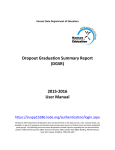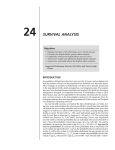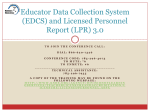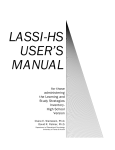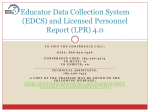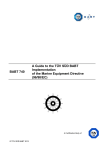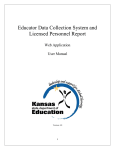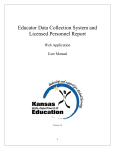Download Kansas Graduation and Dropout Information Handbook 2013-2014
Transcript
Kansas State Department of Education Kansas Graduation and Dropout Information Handbook 2013-2014 The Kansas State Department of Education does not discriminate on the basis of race, color, national origin, sex, disability, or age in its programs and activities. The following person has been designated to handle inquiries regarding the non-discrimination policies: KSDE General Counsel 120 SE 10th Ave. Topeka, KS 66612, 785-296-3204 TABLE OF CONTENTS Table of Contents ............................................................................................................................. 2 Introduction ..................................................................................................................................... 3 Terminology .................................................................................................................................... 3 Data Sources .................................................................................................................................... 4 KIDS Reports..................................................................................................................................... 5 Public Uses of Data .......................................................................................................................... 6 Graduation Calculations................................................................................................................... 7 Four-Year Adjusted Cohort Graduation Rate ............................................................................ 7 Five-Year Adjusted Cohort Graduation Rate ............................................................................. 7 Cohort Start and End Dates ....................................................................................................... 8 Outline of the Cohort Calculation Process ................................................................................ 8 Documentation Required for Adjusting the Four- and Five-Year Cohorts ................................ 9 KIDS EXIT Codes Applied to the Adjusted Cohort Graduation Formula .................................. 11 Frequently Asked Questions about the Graduation Cohorts .................................................. 12 Which School is Responsible for Students in their Fifth Year?................................................ 13 Part-Time Homeschool and Non-Accredited Students ........................................................... 13 Students with Disabilities ........................................................................................................ 14 Dropout Calculation ....................................................................................................................... 15 Dropout Graduation Summary Report .......................................................................................... 15 Correcting Graduation and Dropout Data ............................................................................... 16 Special Circumstances Remove from Cohort .......................................................................... 16 2 Kansas Graduation and Dropout Information Handbook: 2013-2014 August 9, 2013 INTRODUCTION The Kansas Graduate and Dropout Handbook provides a comprehensive overview of how the Kansas State Department of Education (KSDE) calculates and reports the Adjusted Cohort Graduation and Annual Dropout Rates. TERMINOLOGY Term Definition Adjusting the Cohort Dropout The cohort is adjusted by adding students who transfer in to the cohort and subtracting students who transfer out of the cohort. Any student who exits school between October 1 and September 30 with a D27: EXIT/Withdrawal type of 14, 16, 17, 19 or 20 AND does not re-enroll in school by September 30. A web-based application that allows schools and districts to verify the accuracy of their dropout and graduate data submitted via KIDS EXIT & EOYA records. A cohort to capture those students who persist in school and graduate in their fifth year. Dropout Graduation Summary Report Five-Year Cohort Four-Year Cohort Graduate Kansas Individual Data on Students (KIDS) system Non-Graduate Regular High School Diploma The number of students who graduate in four years with a regular high school diploma divided by the number of students who entered high school four years earlier (adjusting for transfers in and out). Any student who exits school by September 30 with a D27: EXIT/Withdrawal type of 8 or 22. The web-based application by which schools submit their student data several times a year for state and federal reporting purposes. Data uploaded from your student information system to KIDS is used to populate the DGSR. Any student who does not graduate by September 30 of their fourth- or fifthyear of high school OR any student who does not transfer to a school or educational program in another state, move to another country or die by September 30 of their fourth- or fifth-year of high school. The standard high school diploma awarded to students in a state that is fully aligned with the state’s academic content standards and does not include a GED credential, certificate of attendance, or any alternative award. September 30th The school the student is assigned to for graduation purposes is determined by the latest EXIT or EOYA record as of September 30. If a student enrolls in a new school prior to September 30 but no EXIT or EOYA records are submitted by that school, then that student will not be in their graduation cohort. He/she will be in the graduation cohort of the school that they transferred from. Transfer In When a student enrolls after the beginning of his/her cohort’s first year in high school. Transfer Out When a student transfers to a school or educational program that culminates in the award of a regular high school diploma, moves to another country or dies. A student who belonged to the school in the prior school year in KIDS on either an ENRL or EOYA record, did not have EXIT record submitted and has not had a KIDS ENRL or ASGT record sent up for the current school year. Unresolved Exit 3 Kansas Graduation and Dropout Information Handbook: 2013-2014 August 9, 2013 DATA SOURCES The following KIDS data collections are used in the graduation and dropout calculations: EOYA Collection: End of Year Accountability (EOYA) records are used to construct a complete list of students who have ever entered or left a graduating class or cohort, as defined by their ninthgrade status. These cohorts, together with all transfers in and transfers out, will be used to calculate the adjusted cohort graduation rates for all students and student subgroups. For more information on KIDS Data Submission Detail-EOYA, go to: http://www.ksde.org/Default.aspx?tabid=2508 EXIT Collection: EXIT records provide information for graduation and dropout counts and for rates calculated and used in AYP determinations. EXIT records are used to pre-populate the DGSR. Exit information (D27 and D28) can only be included on EXIT record types. For more information on KIDS Data Submission Detail-EXIT, go to: http://www.ksde.org/Default.aspx?tabid=2508 The following KIDS Fields are used in the graduation and dropout calculations: D2: AYP/QPA School Identifier: The school (in the D2 field) that submits the latest EXIT/Withdrawal date on an EXIT record or school entry date on an EOYA record is responsible for the student in the graduation and dropout calculations. Remember to use codes 0001 and 0002, when appropriate, so that the student is not included in the graduation calculation. Use 0001 for students educated in assessed content areas out-of-state. Use 0002 for homeschooled students or students attending unaccredited private schools. D10: Current Grade Level: Grade levels seventh through twelfth grade are used in the dropout calculation and grade levels ninth through twelfth are used in the graduation calculations. However, all grades have to submit the DGSR to resolve their unresolved exits. Keep in mind that a student may be coded as non-graded but still be included in the graduation calculations. It depends on when they were first-time 9th graders. D26: EXIT/Withdrawal Date: Schools are required to report an EXIT/Withdrawal date of the student’s last day enrolled at the school or the date the student graduated. EXIT/Withdrawal dates are to be indicators of when a student’s affiliation with a school ended, not an indication of the date a school submitted the EXIT record to KIDS. D27: EXIT/Withdrawal Type: Only students with a value in D10: Current Grade Level of code 13 (eighth grade) or above may have an EXIT record with a D27: Exit/Withdrawal Type of 8=graduated with regular diploma or 22=student with disabilities who met the district graduation requirements for a regular high school diploma, but is remaining in school to receive transitional services deemed necessary by the IEP team. D29: Post-Graduation Plans: The intended post-secondary direction of graduates. This field is required when D27: EXIT/Withdrawal Type = 8, 9 or 22. Remember, post-graduation plans code 9 can only be used when D27: EXIT/Withdrawal Type = 22. 4 Kansas Graduation and Dropout Information Handbook: 2013-2014 August 9, 2013 D32: Primary Disability Code: An indication of whether or not the student has an active IEP which documents that the student receives special education services. In order to report an Exit/Withdrawal Type of 22= Student with disabilities who met the district graduation requirements for a regular diploma, a primary disability must be reported in this field. Additional Student Demographics Included: Gender Socioeconomic status Hispanic Ethnicity Comprehensive Race ESOL Program Participation Residence of Homeless Students Migrant (as reported in the Migrant System) NOTE: Race and ethnicity, as reported in the graduation calculation, are based on the EXIT or EOYA record with the latest school entry date. If the EOYA and EXIT have the same school entry date then the EXIT record will be used. If a student had free/reduced lunch status, was an English Language Learner, migrant, homeless and/or identified as a student with disabilities at any time throughout high school, he or she will be included in that student group in the graduation calculation. KIDS REPORTS Within the KIDS Collection System, there are several reports that can be generated related to graduates and dropouts. Under Standard Reports: Student History: This report can be helpful when reviewing the DGSR because it shows all KIDS records for a particular student ID. Using the records present, a school could determine if the student attended another Kansas school; identify the cohort of the student; and determine in which subgroups the student will be included. Graduates: This report is a valuable tool to use after uploading EXIT records for students that have graduated. Reconcile this report with the commencement program to ensure that all graduates had a graduate EXIT record uploaded. This report could also be used to review the Post-Graduation Plans of graduating students. This report will include any student with a D27: EXIT/Withdrawal type of 8 or 22. Dropouts: This report will return students in grades 7-12 for the AYP school, and any EXIT record with an EXIT/Withdrawal code that counts as a dropout. The AYP definition includes EXIT/Withdrawal Codes of 14, 16, 17, 19 and 20 as dropouts. It is important to remember that this report does not reflect how a student will be counted in the annual dropout calculation for a school in the DGSR. The calculations are more complicated than simply the use of one of these KIDS EXIT codes but this report is a good starting point for monitoring student data reported on students who leave. 5 Kansas Graduation and Dropout Information Handbook: 2013-2014 August 9, 2013 Unresolved Exits: This report can be helpful to resolve and correct unresolved exit data in the early months of the school year (Aug, Sept) before the window to submit EXIT records closes, which corresponds to the date that the DGSR closes. Under Discrepancy Reports: EOYA/EXIT Discrepancy: This report can be used to ensure that EOYA records have been submitted for all students in a building/district. It is important to use this report at the end of the school year to ensure accurate end of year reporting since this is the data that will be used to establish the graduation cohort. Remember this report is only available during the KIDS EOYA submission window. PUBLIC USES OF DATA Once the graduation and dropout data has been reviewed and certified in the DGSR, it is used in federal EDEN reporting, displayed on the Kansas K-12 Reports, used in AYP determinations which you can view in the AYP/QPA Accountability System and is ultimately reported on the Building Report Cards. Building Report Card: http://online.ksde.org/rcard/ Kansas K-12 Report: http://svapp15586.ksde.org/k12/k12.aspx 6 Kansas Graduation and Dropout Information Handbook: 2013-2014 August 9, 2013 GRADUATION CALCULATIONS In 2010, Kansas began using the four-year adjusted cohort graduation rate to calculate graduation rates. Previously, the Kansas graduation rate was calculated by dividing the number of graduates by the sum of the graduates plus dropouts for years one through four of high school. The four-year adjusted cohort graduation method actually provides a more accurate measurement of graduation rates because it tracks the movement of individual students. Four-Year Adjusted Cohort Graduation Rate The four-year cohort graduation rate is the percentage of students in a cohort, adjusted for transfers into and out of the school, district, or state, who graduate with a regular high school diploma within four years of entering high school. The cohort begins with the incoming first-time ninth graders in a given year at a school or district. This cohort is continually adjusted: students who transfer into the school or district are added to the cohort, while students who transfer out of the school or district are removed from the cohort. It is important to note that students who drop out are not removed from a cohort. The cohort at the end of the four- or time frame is called the “adjusted cohort” for the school or district, and the graduation rate for this cohort is defined as the percentage of students in the adjusted cohort who received a regular high school diploma. The four-year cohort graduation rate formula for 2012-2013 is: # 2013 graduates (# of cohort members earning a regular HS diploma by September 30, 2013) # of first-time 9th graders in fall 2009 plus transfers in minus students who transfer out, emigrate, or die during 2012-2013, 2011-2012, 2010-2011 and 2009-2010 Five-Year Adjusted Cohort Graduation Rate The five-year cohort graduation rate is the percentage of students in a cohort, adjusted for transfers into and out of the school, district, or state, who graduate with a regular high school diploma within five years of entering high school. A student who graduates during his/her fifth year of high school will not be counted as a graduate in the four-year cohort rate, but will count as a graduate in the five-year rate. The five-year cohort graduation rate formula for 2012-2013 is: # 2013 graduates (# of cohort members earning a regular HS diploma by September 30, 2013) # of first-time 9th graders in fall 2008 plus transfers in minus students who transfer out, emigrate, or die during 2012-2013, 2011-2012, 2010-2011, 2009-2010 and 2008-2009 7 Kansas Graduation and Dropout Information Handbook: 2013-2014 August 9, 2013 Cohort Start and End Dates Ninth Grade Entry Year 2007-2008 2008-2009 2009-2010 2010-2011 2011-2012 Four-Year Graduation Year 2010-2011 2011-2012 2012-2013 2013-2014 2014-2015 Five-Year Graduation Year 2011-2012 2012-2013 2013-2014 2014-2015 2015-2016 Outline of the Cohort Calculation Process The calculation of the cohort graduation rate is a multi-step process. The steps shown below apply to the calculation of the 2010-2013 four-year cohort graduation rate. The five-year cohort rate process is identical, except that it begins with first-time ninth graders from 2007-2008. Establishing the Cohort The school year with the first EOYA record for a student identified as a 9th grader is used to define membership as first-time 9th graders in a cohort. For the 2013 four-year cohort, students were first-time 9th graders in 2009-2010. For the 2013 five-year cohort, students were first-time 9th graders in 2007-2008. New transfers to the state who are at a grade higher than 9th grade are assigned to the appropriate cohort based on the grade submitted on their EOYA record (i.e. an 11th grade incoming transfer is considered part of the 9th grade cohort from two years prior). After a student is assigned to a cohort, the student cannot be removed from that cohort by subsequent changes in his or her grade. For example, a 9th grade student who, in the following year, appears as an 11th grader or Not Graded remains a member of his or her original cohort. If more than one EOYA record is found, the record with the earliest State entry date is used. Non-graded adult students do not count in the graduation calculation unless their four-year and/or five-year cohort has not graduated. Adjusting the Cohort The cohort is adjusted in two ways: 1. Adding students who transfer into the cohort. 2. Subtracting students who transfer out, move to another country or die. A transfer into the cohort occurs when a student enrolls after the beginning of their cohort’s first year in high school. Students who transfer out must enroll in another school or in an educational program that culminates in the award of a regular high school diploma in order to be removed from the cohort. 8 Kansas Graduation and Dropout Information Handbook: 2013-2014 August 9, 2013 Before submitting an EXIT record removing a student from a cohort, the school must obtain documentation that the student transferred out, moved to another country or is deceased (see next section for a list of appropriate documentation). Finalizing the Cohort The 2013 graduation rate is the number of students in the cohort earning a regular high school diploma by September 30, 2013; early graduates should be included. The school the student is assigned to for graduation purposes is the school that submits the EXIT record with the latest EXIT/withdrawal date or EOYA record with latest school entry date (if no EXIT record has been submitted) as of September 30, 2013. EXIT records from the KIDS system determine the status of a student at the time of the graduation calculation. If more than one EXIT record exists for a student, the record with the latest EXIT/Withdrawal date is used. The only exception is if it is a duplicate graduate EXIT record. Then, if more than one graduate EXIT record exists for a student, the record with the earliest EXIT/Withdrawal date is used. If a student is remaining in school for a fifth (or sixth) year, they will not have an EXIT record. In which case the EOYA record is used. These students will count as non-graduates in the four-year cohort graduation calculation. Race and ethnicity subgroups are based on status reported on the last available record (EXIT or EOYA). Other subgroups (Limited English Proficient, Students with Disabilities, Economically Disadvantaged, Migrant and Homeless) are based on membership in the subgroup at any time during high school. Documentation Required for Adjusting the Four- and Five- Year Cohorts The following is a summary of appropriate documentation from the High School Graduation Rate Guidance provided by the US Department of Education. This document can be found in its entirety on the KSDE graduation webpage: http://www.ksde.org/Default.aspx?tabid=4606. KSDE will not collect documentation but it should be maintained by the school in the event there is an audit. KSDE recommends that schools keep their documentation for two years following the end of the student’s four-year cohort. Before any EXIT record is submitted that would transfer a student out of the cohort, the school should make sure that they have the following appropriate documentation. 9 Kansas Graduation and Dropout Information Handbook: 2013-2014 August 9, 2013 Transfer within State If a student transfers to an accredited public or private school in the State, that transfer is recorded in the State’s data system; thus, a record from the State’s data system would be considered official written documentation. In Kansas, only EOYA and EXIT records submitted in the KIDS System are used in the graduation calculation to transfer students from one school to another. Assignment (ASGT) and Enrollment (ENRL) records are not used in the graduation calculation. Transfer Out of State To confirm that a student transferred out of state, a school must have “official written documentation” that a student has transferred to another school or educational program that culminates in the award of a regular high school diploma. Examples of official written documentation include, but are not limited to: a request for student records from a receiving public or private high school or an educational program (that culminates in a regular high school diploma); a written record of a response from an official in the receiving school or program acknowledging the student’s enrollment; or a copy of the student’s transcript from the receiving school or program. A conversation with a parent or neighbor of a student, for instance, would not be considered official written documentation of a transfer out of state. Transfer Out of Country To confirm that a student has moved to another country, a school must have written confirmation, but need not obtain official written documentation. For example, if a parent informs a school administrator that the family is leaving the country, the school administrator may document this conversation in writing and include it in the student’s file. The federal regulations do not require written documentation to be “official” for a student who moves to another country because it may be difficult, if not impossible, to obtain transcripts or other official documentation from another country confirming that the student is enrolled in school. Foreign-Exchange Student Most foreign-exchange students return to their home country after their program has concluded. The same documentation required for students who move out of the country would apply to foreignexchange students. Another acceptable form of documentation would be a letter confirming the student’s enrollment in a foreign-exchange program. Student Death In the tragic event that a student dies, an obituary or letter from a family member would be sufficient documentation. 10 Kansas Graduation and Dropout Information Handbook: 2013-2014 August 9, 2013 KIDS EXIT Codes Applied to the Adjusted Cohort Graduation Formula D27 EXIT/Withdrawal Type in KIDS Transfer to a public school in the same district EXIT Code 1 3 4 Impact on Cohort Transfer Out or Non-Graduate Transfer Out or Non-Graduate Transfer Out Transfer Out Mathematical Effect on Graduation Rate Increases rate if student attends another public school; decreases rate if student does not Increases rate if student attends another public school; decreases rate if student does not Increases rate Increases rate Transfer to a public school in a different district in Kansas Transfer to a public school in a different state Transfer to an accredited private school in Kansas or in a different state Transfer to a non-accredited private school in Kansas or in a different state Transfer to home schooling Matriculation to another school 2 5 Non-Graduate Decreases rate 6 7 8 10 11 12 13 14 15 Non-Graduate Transfer Out or Non-Graduate Graduate Transfer Out Non-Graduate Non-Graduate Non-Graduate Non-Graduate Transfer Out Decreases rate Increases rate if student attends another public school; decreases rate if student does not Increases rate Increases rate Decreases rate Decreases rate Decreases rate Decreases rate Increases rate Graduated with regular diploma Student death Student illness Student expulsion (or long-term suspension) Reached maximum age for services Discontinued schooling Transfer to an accredited or non-accredited juvenile correctional facility where educational services are provided Moved within the US, not known to be enrolled in school Unknown Student data claimed in error 16 Non-Graduate Decreases rate 17 18 Decreases rate Neutral 19 20 Non-Graduate Removes preceding ASGT record Non-Graduate Non-Graduate Transfer to a GED completion program Transfer to a juvenile or adult correctional facility where educational services are not provided Student moved to another country, may or may not be continuing (applies to foreign exchange students) Student with disabilities who met the district graduation requirements for a regular diploma, but is remaining in school to receive transitional services deemed necessary by the IEP team Undo a previously submitted EXIT Record 21 Transfer Out Increases rate 22 Graduate Increases rate 99 Removes preceding EXIT Neutral Decreases rate Decreases rate *EXIT code 9 was removed at the start of the 2012-2013 school year. 11 Kansas Graduation and Dropout Information Handbook: 2013-2014 August 9, 2013 Frequently Asked Questions about the Graduation Cohorts Q: What is a regular high school diploma? A: A regular high school diploma means the standard high school diploma awarded to students in a state that is fully aligned with the state’s academic content standards and does not include a GED credential, certificate of attendance, or any alternative award. Q: If a student transfers to a virtual school, will he/she be removed from the cohort? A: If a student transfers to a Kansas accredited virtual school or program, he/she would transfer out of the cohort of the exiting school. If a student transfers to a virtual school or program that is not state accredited, he/she would remain in the cohort of the exiting school because this educational program does not yield a regular high school diploma. A list of state accredited virtual schools can be found on the graduation webpage: http://www.ksde.org/Default.aspx?tabid=4606. Q: If a student transfers to a private school, will he/she be removed from the cohort? A: If a student transfers to a Kansas accredited private school, he/she would transfer out of the cohort of the exiting school. If a student transfers to an unaccredited private school, he/she would remain in the cohort of the exiting school because this educational program does not yield a regular high school diploma. A list of state accredited private schools can be found on the graduation webpage: http://www.ksde.org/Default.aspx?tabid=4606. Q: If a student transfers to a homeschool, will he/she be removed from the cohort? A: If a student transfers to a homeschool, he/she would remain in the cohort of the exiting school because this educational program does not yield a regular high school diploma. Q: How are students who graduate in less than four years counted in the graduation rate? A: Students who graduate in less than four years will count as an on-time graduate in the calculation of the graduation rate for their ninth grade cohort. In essence, their graduation will be “banked” to be included when their cohort’s graduation rate is calculated. Q: Are schools held accountable for students who transfer into the school but are not on schedule to graduate in four years? A: Yes, after a student has been claimed by a school in the KIDS system, the claiming school has the responsibility of graduating the student with his/her cohort. If the student does not graduate with his/her cohort they will count as a non-graduate in the four-year adjusted cohort graduation rate. However, if the student graduates within five years, he/she will count as a graduate in the five-year adjusted cohort graduation rate. Q: How do non-graded students fit into the graduation calculation? 12 Kansas Graduation and Dropout Information Handbook: 2013-2014 August 9, 2013 A: Non-graded students do not count in the graduation calculation if their four-year or five-year cohort has already graduated. If their four-year or five-year cohort has not graduated, they are included in the graduation calculation. Which School is Responsible for Students in their Fifth Year? There is confusion as to which school will be responsible for fifth-year students in the four- and five-year cohorts. There are three common scenarios that could occur and each assigns ownership differently. Scenario 1: The student does not graduate from school A in May 2013. School A submits EOYA and EXIT records for the student in June. The student enrolls in school B during the summer 2013. The student is still enrolled in school B on September 30, 2013. School A has ownership in the four-year cohort because their EOYA record was the last record received as of September 30, 2013. School B submitted neither an EOYA record (because it was not during the EOYA window) nor an EXIT record (because the student is still enrolled). School B has ownership in the five-year cohort (unless the student transfers to another school). Scenario 2: The student does not graduate from school A in May 2013. School A submits an EOYA record for the student in June. The student enrolls in school B during the summer 2013. The student leaves school B prior to September 30, 2013. School B submits an EXIT record for the student prior to September 30, 2013. School B has ownership in the four-year cohort because their EXIT record was the last record received as of September 30, 2013. School A submitted an EOYA record but it was prior to School B’s EXIT record. School B has ownership in the five-year cohort (unless the student transfers to another school). Scenario 3: The student does not graduate from school A in May 2013. School A submits an EOYA record for the student in June. The student enrolls in school B during the summer 2013. The student graduates from school B prior to September 30, 2013. School B submits a graduate EXIT record for the student prior to September 30, 2013. School B has ownership in the four-year cohort because their EXIT record was the last record received as of September 30, 2013. School A submitted an EOYA record but it was prior to School B’s EXIT record. School B has ownership in the five-year cohort because the student graduated. How do Part-Time Homeschool and Non-Accredited Private School Students Count in the Graduation Calculation? If a homeschool or non-accredited private school student attends a public school part-time, they should not be included in the four- or five-year graduation cohorts. Schools can use code 0002 in KIDS Field D2 (AYP/QPA School) to ensure that students enrolled in homeschools and non-accredited private schools 13 Kansas Graduation and Dropout Information Handbook: 2013-2014 August 9, 2013 and attending public schools part-time for particular electives and/or content areas will be excluded from the graduation calculation. These students should now be coded 0002 on all KIDS submissions. The graduation calculation looks specifically at EXIT and EOYA records, but it is important that all records be submitted with 0002 in the D2 Field. All EXIT and EOYA records with 0002 in the D2 Field will be excluded from the graduation calculation. How do Students with Disabilities Count in the Graduation Calculation? The federal guidance is very specific that any student, regardless of the reason, who doesn’t graduate in four years, will count as a non-graduate in the four-year cohort. This disproportionately affects students with disabilities who can remain in school until age 21 for educational services. In the 2012-2013 school year, a new EXIT code was added specifically for students with disabilities who have met the graduation requirements for a regular diploma but are remaining in school to receive transitional services deemed necessary by the IEP team. KSDE believes that since these students have met the graduation requirements for a regular diploma, they should count as graduates in the DGSR, even though they are going to remain in school for transitional services. It is important to note that this is only a quasi-EXIT code. It alerts KSDE to count the student as a graduate in the graduation calculation, but should not actually exit the student from your local SIS because you will still need to send subsequent records on the student. Here is the process for utilizing new EXIT code 22: Once the student meets the criteria of the EXIT code, an EXIT records with a D27: Exit/Withdrawal Type of 22= Student with disabilities who met the district graduation requirements for a regular diploma, but is remaining in school to receive transitional services deemed necessary by the IEP team should be submitted in the KIDS system. If D27: Exit/Withdrawal Type=22, then D29: Post-Graduation Plans must be 9=Receiving special education transition services. If D27: Exit/Withdrawal Type=22, then D32: Primary Disability Code must be a valid, nonblank value. The student will then continue to receive transitional services in following years and will be submitted on subsequent KIDS records until he/she is no longer receiving transitional services. Once the student is no longer receiving transitional services, another EXIT record should be submitted with a D27: Exit/Withdrawal Type of 8=Graduated with regular diploma. (Failure to submit this second EXIT record could result in the student appearing as an unresolved exit in the DGSR) This EXIT code does not apply to all students with disabilities who remain in school beyond their fouryear cohort. It only applies to students with disabilities who have met the graduation requirements for a regular diploma but are remaining in school to receive transitional services deemed necessary by the IEP 14 Kansas Graduation and Dropout Information Handbook: 2013-2014 August 9, 2013 team. Please note that a regular diploma refers to the general diploma the school/district issues to the general population. It does not include an alternate graduation plan for students that are not in the regular curriculum. DROPOUT CALCULATION The dropout rate is calculated annually and reflects the number of seventh– twelfth grade students who drop out in any one school year. A dropout is any student who exits school between October 1 and September 30 with a dropout EXIT code AND does not re-enroll in school by September 30. The KIDS EXIT codes that count towards the dropout rate include: 14: Discontinued schooling 16: Moved within the US, not known to be continuing 17: Unknown 19: Transfer to an adult education facility (i.e. for GED Completion) 20: Transfer to a juvenile or adult correctional facility where educational services are not provided Any unresolved exits in grades 7-12 will also be counted in the dropout calculation. The dropout rate is not the inverse of the graduation calculation for two specific reasons: 1. The annual dropout rate is calculated using one year of data while the graduation rate is calculated using four years of data. 2. The dropout rate is calculated on seventh-twelfth grade students while the graduation rate is calculated on ninth-twelfth grade students. DROPOUT GRADUATION SUMMARY REPORT (DGSR) The DGSR provides all schools and districts an opportunity to review and certify their dropout and graduation data are correct before submitting the report to KSDE. The DGSR is an online application that is accessible through the KSDE Authentication page. This report focuses on three key pieces of data: • Post-Graduation Plans • Dropouts • Graduates (four-year and five-year cohorts) For more information about the DGSR, please reference the DGSR User Manual located on the KSDE graduation webpage: http://www.ksde.org/Default.aspx?tabid=4606. 15 Kansas Graduation and Dropout Information Handbook: 2013-2014 August 9, 2013 Correcting Graduation and Dropout Data Corrections to graduation and dropout data cannot be made within the DGSR; updated EXIT records must be submitted in the KIDS system. If an EXIT record is submitted for a student with incorrect information, submit an EXIT record with the same State Student Identifier, AYP School, and Exit Date with the corrected information to update the student’s EXIT record. If an EXIT record is submitted with an incorrect D26: Exit/Withdrawal date, submit an EXIT record with the same State Student Identifier, AYP School, and Exit Date with a D27: EXIT/Withdrawal code of “99” to “undo” that EXIT record in KIDS. Then submit another EXIT record with the correct D26: Exit/Withdrawal date. If an EXIT record is accidentally submitted for a student who did not really leave, submit an EXIT record with the same State Student Identifier, AYP School, and Exit Date with a D27: EXIT/Withdrawal code of “99” to “undo” that EXIT record in KIDS. Any records submitted with D27: EXIT/Withdrawal type “99” must be sent with the same EXIT year as the original record that the “99” is intended to “undo. Otherwise the record will not “undo” the original EXIT record. These submissions must take place PRIOR to submitting the DGSR for the affected building and district. Otherwise the records will not process. EXIT records with D26: EXIT/Withdraw dates between 10/1/2012 and 9/30/2013 will be accepted until the DGSR has been submitted. No EXIT records will be accepted with a D26: Exit/Withdrawal date prior to 10/1/2012. After this report has been submitted, only EXIT records with D26: EXIT/Withdraw dates after 9/30/2013 will be accepted. Remove from Cohort Under special circumstances, a school can remove a student from the current four-year cohort. Remove from cohorts typically occur because the student’s EXIT record cannot be corrected in the KIDS system. Schools can submit students to be removed from the cohort when they review their DGSR in the fall. The following are approved remove from cohort reasons: Student was a homeschool student who attended classes at the public school part-time Student was a non-accredited private school student who attended classes at the public school part-time Student died after they were exited from the school Student transferred to a school in another state after they were exited from the school Student is an adult whose cohort has already graduated Other very unique situations in which the student was included in the cohort and as a result of subsequent actions should be removed from the cohort 16 Kansas Graduation and Dropout Information Handbook: 2013-2014 August 9, 2013


















